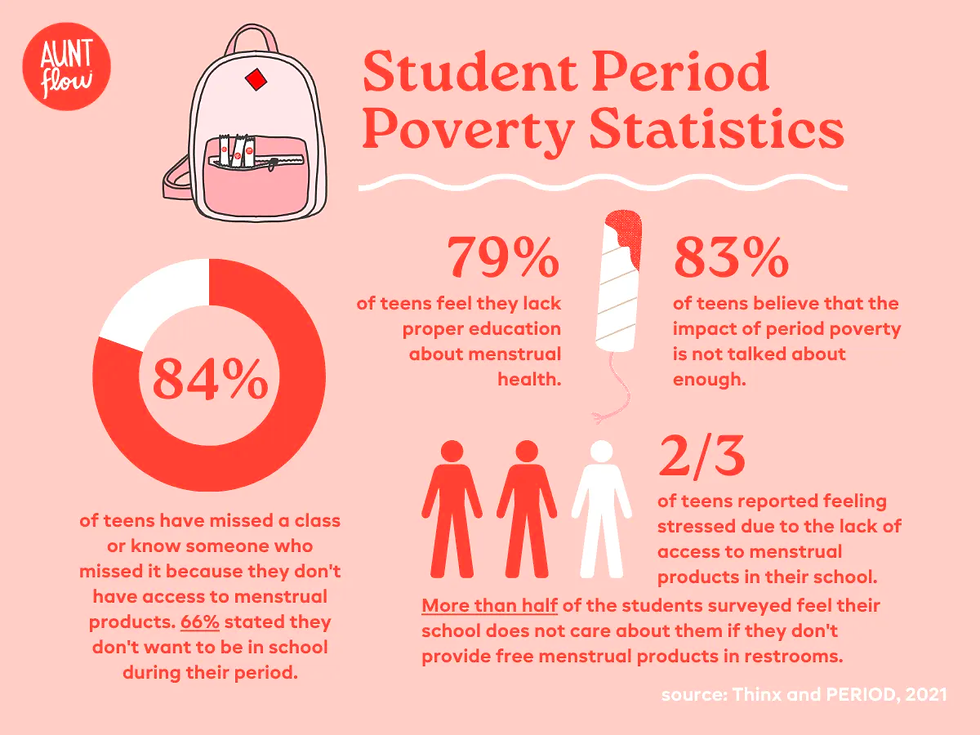Period Poverty: a Public Health Crisis
- Ananya
- Jul 30, 2023
- 4 min read

A person may use over 10,000 tampons or 11,000 pads in a lifetime, with an average person spending $20 per cycle on menstrual products. If you haven’t guessed it already, that means that thousands of dollars worth of product. According to the National Organization of Women, this means that menstruators spend over $18,000 on average in their lifetime on period products. This is so far from cheap, so much so that a study published in May 2021 shared how 2 in 5 people struggle with access to period supplies, with the number being up 35% since 2018. Period poverty, the lack of access to menstrual hygiene products and adequate menstrual education, has emerged as a public health and human rights crisis affecting millions worldwide. This pressing issue not only undermines women's dignity and rights but it also has far-reaching consequences for their physical and mental well-being, education, and economic opportunities with a dire need for resolution.

Period poverty is a multifaceted issue that primarily stems from financial constraints and socio-cultural norms. Many women and girls from low-income households struggle to afford menstrual products, forcing them to resort to makeshift insanitary alternatives like rags, newspapers, or even leaves. Inadequate access to clean and safe facilities for changing and disposing of menstrual products further exacerbates the problem making them highly susceptible to a variety of infections. Furthermore, the societal stigma surrounding menstruation in certain cultures often leads to a lack of education and communication about menstrual health, leaving women and girls unprepared, confused, and ashamed when facing their periods.
So, how does period poverty impact public health globally?
1. Health Risks: Using unhygienic materials (like the aforementioned during menstruation can lead to serious health complications, including infections and reproductive health issues. The absence of proper menstrual hygiene products compromises the overall health of women and girls and increases their vulnerability to potentially fatal and highly painful diseases with a capacity to cause fertility issues.
2. Mental Health: Period poverty can cause immense stress and anxiety for those who cannot afford menstrual products. The shame associated with not being able to manage menstruation adequately can lead to feelings of inadequacy and low self-esteem, affecting mental well-being and one’s dignity. The air of confusion that comes with the cultural stigmas implicates a lack of communication and misinformation, resulting in a greater susceptibility to issues like depression. A publication from the NIH stated that “the prevalence of risk of poor mental health is higher among women with period poverty (62.6%) than those without this kind of deprivation (50.0%)”
3. Education: Girls facing period poverty are often compelled to miss school during their menstruation days, disrupting their educational opportunities, and perpetuating gender inequality. This lack of attendance contributes to educational gaps and hinders their future prospects resulting in a vicious cycle of period poverty that urgently needs to be ceased and overcome.
4. Economic Barriers: For women in the workforce, as for girls in school, period poverty can diminish their productivity and attendance. Additionally, the financial burden of purchasing menstrual products each month can take a toll on household budgets. Many menstruators in poverty have reported that they had no other option than to exchange their food stamps to purchase menstrual products, thus compromising on their meals.
To tackle period poverty, we must work to challenge the sociocultural taboos surrounding menstruation that rid our communities and foster open dialogue. By creating an environment that encourages communication, we can normalize discussions about periods, break down myths, and debunk the stigma associated with menstruation. Governments, educational institutions, and non-profit organizations must collaborate to implement comprehensive menstrual education programs, aiming to equip people with knowledge about the maintenance of menstrual hygiene and their reproductive health.
It is crucial to ensure that menstrual hygiene products are accessible and affordable for all women and girls, particularly those from marginalized communities. Initiatives like providing free menstrual products in schools, community centers, and public restrooms can significantly alleviate period poverty and empower women to manage their periods with dignity. This is one of the central agendas of my organization, Youth 4R^3. We are currently running a fundraiser for the distribution of these menstrual products and for conducting educational workshops among these marginalized communities facing period poverty.
Empowering menstruators to produce and sell menstrual products locally can create economic opportunities while also addressing period poverty. Entrepreneurship programs can offer necessary training and support to menstruators that they may have missed out on due to their lack of access to menstrual products. Such training - whether it’s for menstrual product businesses or not - allows them to gain valuable skills that are attractive in the job market enabling them to free themselves from the binds of the vicious poverty cycle. By promoting the manufacturing and distribution of affordable, eco-friendly menstrual products within their communities: they can satisfy the needs of people facing the same problems they are or were once facing.
Period poverty is not only a matter of hygiene but one of fundamental human rights and public health. By addressing the economic, social, and cultural factors that contribute to period poverty, we can alleviate the burden faced by millions of menstruators worldwide. Sustainable solutions, such as comprehensive menstrual education, accessible menstrual products, and entrepreneurial empowerment programs, are crucial in breaking the cycle of period poverty and paving the way for a healthier, more equitable future for all. As a society, it is our responsibility to prioritize this issue and work towards eradicating period poverty, promoting menstrual equity, and empowering people to embrace their periods with pride and confidence.



Comments